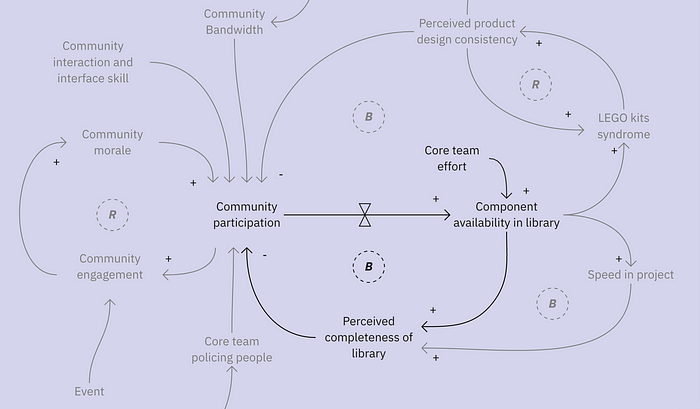System thinking for design systems
We put “system” in the name, but have we really look this from a system perspective?
Systems are everywhere. We just need to learn to see them.
Your car is a system—a set of interconnected elements that work together.
A football team is a system—with an element such as players, coach, ball, and field. You change one element, you change the system.
I’m not a system expert, but after learning system thinking, I approach the problem differently. My goal in this article is to share how I use the system lens to enable participation and contribution to our design system. I hope this can spark a discussion in the community.

System thinking for design systems
The diagram above is known as a causal loop.
It tells a story of what elements affect the contribution in the design system. This causal loop explains my mental model of how the system works (based on my observation). It’s only a small part of a larger causal loop I have. Once I have it visualized, I can play it around and test my model.
It helps me to see how things are interconnected.
Let’s go through examples.
Example 01: Help me anticipate intangible barrier
I believe that the higher the community participation ➔ which leads to more components available. But it doesn’t stop there. The more component available➔ it increases the perceived completeness of the library ➔ which makes people reluctant to challenge or critique the library.

As I lead the design system effort, this tool helps me to anticipate that the perception of completeness can gets in the way.
For example, we could incorporate things like “confidence level” in our documentation site. The confidence level would send a signal to the team that not everything in the library is complete or good.
The idea to put the “confidence level” might not work and require further discovery. In practice, I’ll definitely not jump to the solution too quickly.
Example 02: Anticipate unhealthy culture
I’ve argued before that without the right culture, design systems can create a LEGO kits syndrome. This mental model is also captured here:
The more components available in the library ➔ (+) it increases the chance of LEGO kits syndrome happens in the team ➔ (+) which then creates an illusion that the design looks consistent ➔ (-) which leads to a lower community participation.

By visualizing my mental model from experience and observation. I can then test a few interventions to reduce the LEGO kits syndrome. For example, by having a session where everyone can propose a new improvement so that the culture around the design system is inclusive and participatory.
How to start learning system thinking
I highlighted how the causal loop can help me to be aware of the underlying system. This practice is not limited to design systems, of course. In fact, the community of system thinkers uses this to examine hard issues, like the Israeli-Palestinian conflict.
You can start by learning the simple basics, just like in sport. Before you want to master the complex moves, you start with the basic moves. So, what are those basic moves?
Think in the loop
Typically, we think in a straight line like Satisfied customers ➔ lead to positive word of mouth ➔ lead to more sales.
But since most of the things are interconnected in the real life. Think in the loop can help us see how each element affecting the other. This way, we can start to see a causal relationship and pose a few questions to test our model.

See things as a system, not snapshots
We often see things in a snapshot. For example, when I was in elementary school, I assume my friend Tony was someone that is not motivated and labeled him as “lazy”.
In reality, Tony had an issue in his family and he didn’t have the mental space and energy to learn in school. The thought of his parents fighting and yelling was exhausting for him.
If only I could be more empathetic and see things as a system, my action, and my thinking would be different. Which affects Tony in a different way, and perhaps leads to a different future.
It’s a system, not one thing.
If you’re interested, here are a few starting points to learn about system thinking: https://thesystemsthinker.com/ and my favorite book Donella H. Meadows: Thinking in Systems
Best,
Budi | buditanrim.co | I’m on Twitter: buditanrim

Other articles about design systems:
- Design system: LEGO Kits syndrome
- System thinking for design systems
- You might need a collaboration ground for design systems
- Subscribe to my newsletter: https://buditanrim.co/newsletter/
If you find this article useful, please consider giving it applause to make it easier for other people easy to find this as well.
